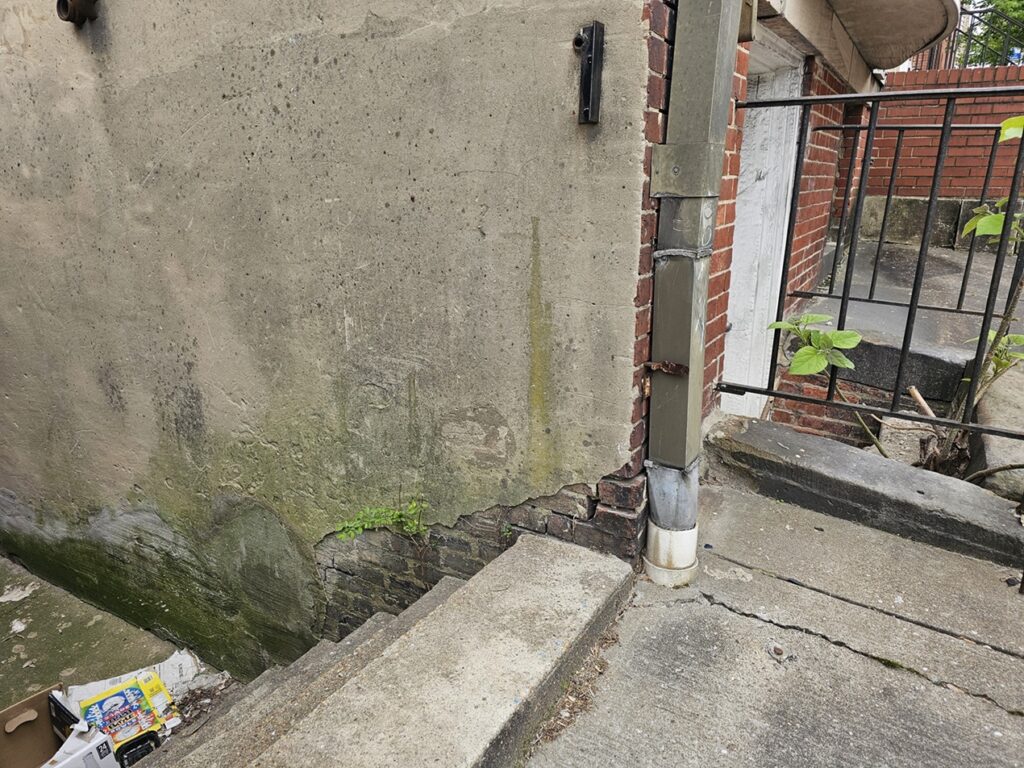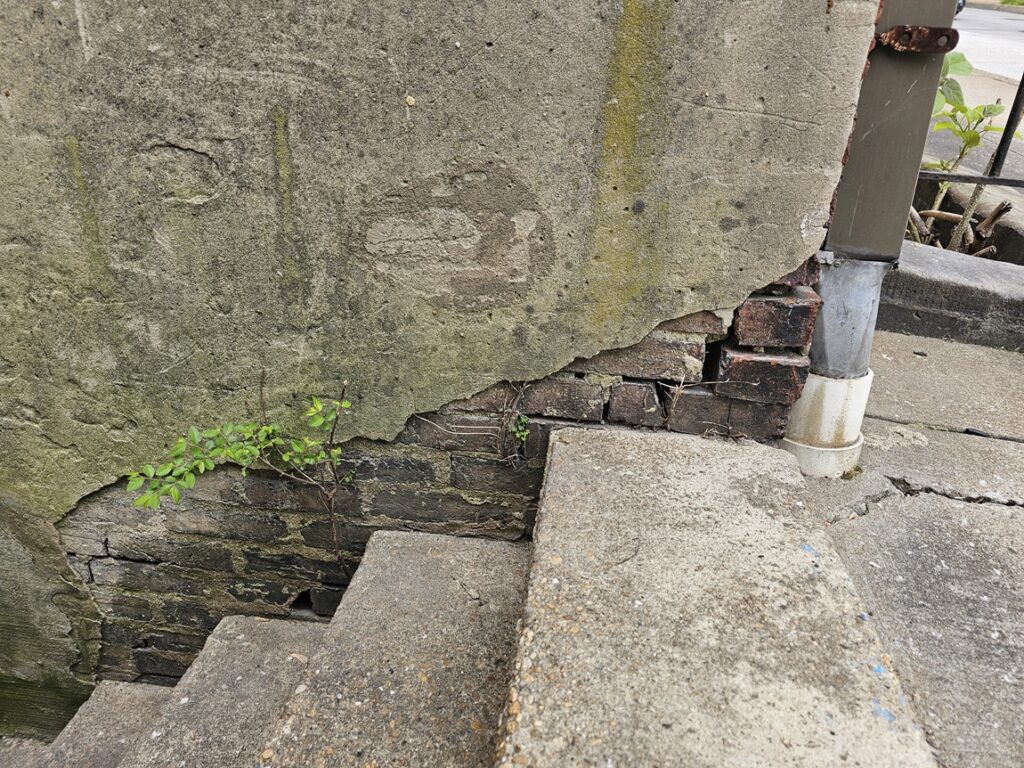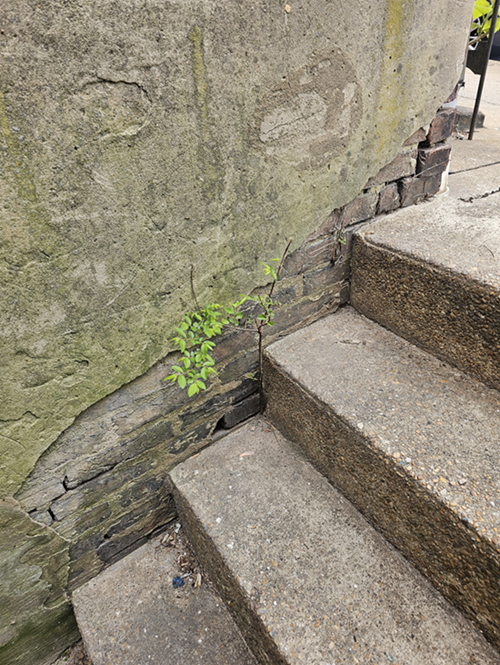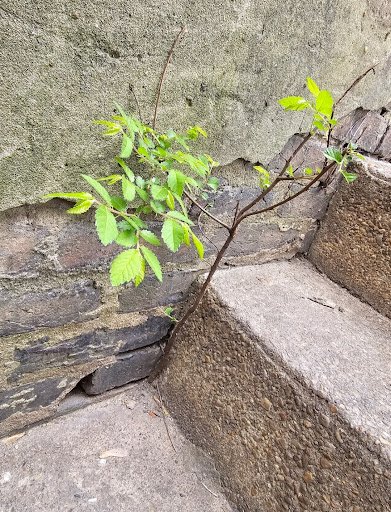Understanding the Causes and Solutions for Stairway Base Wall Deterioration
As you might go, walking down the streets of Washington DC, you have probably walked past many sets of external steps in the masonry and concrete layout of our buildings and noticed a stairway. You may have seen deterioration around the base of the wall, especially if it’s a brick facade and a stairway to the basement. Most of the ones you walk past have one or more typical problems. Problems at this location are prolific because the stairway to an underground basement or entrance to the building generally has a much higher amount of moisture than most other parts of the building facade. These areas have highly elevated moisture for several reasons:
These areas have highly elevated moisture for several reasons:
- Ground moisture. They are generally suppressed or below grade which means they have a higher amount of exposure to ground moisture, even through the concrete and masonry from a phenomenon called rising damp.
- Less air exposure. Prolonged dry times, meaning these areas take longer to dry out, which means it stays wetter longer. These areas don’t have as much exposure to open areas or exposed sides, instead they’re binded or confined on two or more sides. That means they have less air flow around them and therefore dry out slower.
- Less sunlight exposure. Because they are at the lowest parts of the building, sometimes even below grade, they generally have the lowest amount of exposure to sunlight. Having less exposure to sunlight means that areas like masonry facades, in the outdoors, will stay wetter longer.
In the picture below, you can see that a parge cement or stucco coat has been applied on top of the face of the bricks, but that application of cementitious coating has deteriorated and fallen off of most of the area above the stair treads. There’s even a plant growing out of a part of the masonry facade; plants like that don’t grow in areas of masonry or concrete when they are well maintained and or have less overall deterioration. Bio colonization, the phenomenon of plants growing in or on masonry and or concrete surfaces only happens in combination of both neglect and deterioration.

When you look more closely at the plant, you can tell that it’s not just a delicate or weak tissue type plant, in this case it happens to be a type of deciduous tree.

This particular tree is not just a deciduous tree, which is a hardwood perennial plant, but this happens to be a Chinese Elm tree. Elm trees are very strong and known for extremely dense wood. Of all of the elm trees though, the Chinese Elm is one of the strongest fiber trees. The wood from these trees is so strong that it’s used to make baseball bats, for example. The strength of the wood fiber of this plant is one of the many reasons why it’s bad to have a plant like this growing between the foundation of a brick wall and an adjacent stairway. As the tree grows it will cause significant damage to the building and will be very difficult to remove. These trees become more difficult to remove as time goes by because once they set roots deep into the foundation of the building it’s very hard to kill those deep roots. When the plant is nascent and young, like the one shown here in these photos, it’s more easy to remove, but once it grows large it becomes extremely difficult to remove or kill without using toxic chemicals.

The biocolonization and plant growth shown here, is just one of the examples or symptoms of the greater problem of deterioration and specifically the nonlinearity of the curve of the deterioration. Masonry and most types of building materials deteriorate naturally over time in a process of entropy. Entropy and associated deterioration are a fundamental principle in both manufactured building materials and natural elements.
Entropy is a measure of disorder or randomness in a system, and it tends to increase over time according to the Second Law of Thermodynamics. In the context of building materials, this means that even well-constructed and maintained structures will gradually break down and become more disordered over time.
For masonry and concrete, this entropic process comes about in various ways:
- Chemical reactions: Environmental factors like air pollution, acid rain, carbon dioxide, and even just hydration from precipitation in the atmosphere will react with the components of masonry and concrete, leading to deterioration. For example, carbonation in concrete can lead to the corrosion of reinforcing steel.
- Physical weathering: Cycles of freezing and thawing, thermal expansion and contraction, and mechanical stresses from wind and vibrations all contribute to the gradual breakdown of these materials.
- Biological factors: like the more complex deciduous tree organisms discussed above, even simple forms of biocolinization like algae, lichens, and other organisms can grow on and within these materials, contributing to their deterioration.
- Material fatigue: Repeated loading and unloading of structures can lead to microscopic cracks and weakening over time.
- Crystallization of salts: In porous materials like some types of masonry, dissolved salts can crystallize and expand, causing physical stress and deterioration.
These processes are all signs and results of increasing entropy. The ordered structure of the building materials gradually becomes more disordered as they interact with their environment and are subjected to various environmental stresses and further deterioration over time.
While this process is inevitable due to the laws of nature, proper design, construction techniques, and regular maintenance can significantly slow the rate of deterioration, extending the useful life of buildings and structures. Our company is dedicated to preserving these historic masonry structures here in Washington DC. In the next blog this coming week we’ll look at some of these same topics we’re closely and explain the fundamentals and mechanics of the specific types of deterioration.
If you are looking for a masonry restoration contractor that takes historic preservation seriously, reach out to us. Our company can help.
You can reach us by telephone at (202) 796-7644 and you can reach us by email from the contact form on our website at https://duponttuckpointingmasonrydc.com/contact-us/.




